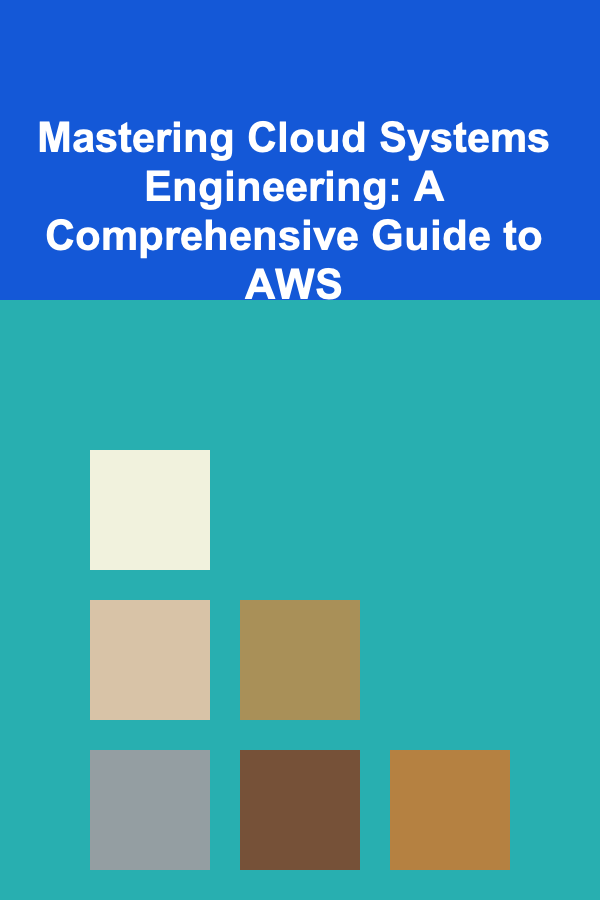
Mastering Cloud Systems Engineering: A Comprehensive Guide to AWS
ebook include PDF & Audio bundle (Micro Guide)
$12.99$7.99
Limited Time Offer! Order within the next:

Cloud computing has revolutionized how businesses manage and deploy IT resources, making scalability, reliability, and cost-efficiency more accessible than ever before. Among the various cloud service providers, Amazon Web Services (AWS) stands as a leader in the industry, offering a wide range of services that power everything from startups to global enterprises. As a systems engineer, mastering AWS can significantly enhance your ability to design, deploy, and manage cloud infrastructure effectively.
This comprehensive guide will walk you through the fundamental principles and actionable steps to master cloud systems engineering with AWS. Whether you're a beginner or looking to deepen your knowledge, this guide covers key AWS concepts, best practices, and advanced techniques for managing cloud systems efficiently.
Understanding AWS and Its Core Components
Before diving into advanced AWS concepts, it's essential to build a solid foundation by understanding the core components that make up AWS. AWS provides a suite of cloud computing services that can be categorized into several domains such as compute, storage, networking, databases, and security.
Key Components:
- Compute: AWS offers various compute services like Amazon EC2 (Elastic Compute Cloud), Lambda (serverless computing), and Elastic Beanstalk (Platform as a Service). EC2 is the most commonly used service for provisioning virtual servers, while Lambda allows you to run code without provisioning servers.
- Storage: Amazon S3 (Simple Storage Service) is the go-to object storage solution in AWS, designed for scalability, data durability, and easy access. Amazon EBS (Elastic Block Store) provides persistent block-level storage for EC2 instances, while Amazon EFS (Elastic File System) is a scalable file storage service.
- Networking: AWS includes a comprehensive set of networking services like VPC (Virtual Private Cloud), which allows you to create a private network within AWS, and Route 53 for DNS management. AWS Direct Connect enables a private connection from your data center to AWS.
- Databases: AWS supports both relational and non-relational databases. Amazon RDS (Relational Database Service) and Aurora provide managed relational databases, while DynamoDB is a managed NoSQL database service. Additionally, AWS offers database migration tools to assist in seamless migration to the cloud.
- Security: Security is paramount in AWS. The AWS Identity and Access Management (IAM) system enables you to manage user access and permissions. AWS also provides services like AWS Shield for DDoS protection, AWS WAF (Web Application Firewall), and AWS KMS (Key Management Service) for encryption.
Actionable Tips:
- Start by familiarizing yourself with the AWS Management Console. This is your main interface for interacting with AWS services.
- Explore AWS Free Tier, which provides free access to a limited number of AWS resources for 12 months to practice and learn without incurring costs.
Key Principles of Cloud Systems Engineering
Cloud systems engineering focuses on designing, building, and managing complex cloud architectures. There are several key principles that every cloud systems engineer should follow to ensure their cloud infrastructure is robust, scalable, and cost-effective.
Scalability and Elasticity:
AWS enables you to scale your infrastructure based on demand. This elasticity allows you to provision resources dynamically, scaling up or down to meet traffic fluctuations.
- Vertical Scaling: Increasing the resources of an existing server (e.g., increasing CPU or RAM).
- Horizontal Scaling: Adding more servers (e.g., load balancing EC2 instances) to distribute traffic across multiple instances.
Actionable Tip : Use Auto Scaling and Elastic Load Balancing (ELB) to automatically adjust the number of EC2 instances based on traffic demand, ensuring high availability and optimized performance.
High Availability and Fault Tolerance:
High availability is critical for cloud systems, as downtime can significantly affect your business. AWS offers multiple services and architectures to ensure that your systems remain available even during failures.
- Multi-AZ Deployments: Deploying across multiple availability zones (AZs) in AWS ensures that your application remains online even if one AZ experiences a failure.
- Backup and Disaster Recovery: AWS provides various backup solutions, including automated snapshots in EC2 and RDS, as well as cross-region replication in S3.
Actionable Tip : Implement a multi-AZ deployment for mission-critical applications to avoid single points of failure and ensure business continuity.
Security and Compliance:
In cloud systems engineering, security is a shared responsibility between AWS and you. While AWS manages the security of the cloud infrastructure, you are responsible for securing your applications, data, and access control.
- IAM Roles and Policies: Use IAM to control who can access AWS services and resources. Create granular policies to restrict permissions based on the principle of least privilege.
- Encryption : AWS provides robust encryption capabilities for data at rest (e.g., with S3, RDS) and data in transit (e.g., with SSL/TLS). Use AWS KMS to manage encryption keys securely.
Actionable Tip : Regularly audit your IAM roles and policies using AWS IAM Access Analyzer to ensure that you are adhering to security best practices.
Advanced AWS Services for Systems Engineers
Once you have a solid understanding of AWS fundamentals, you can start exploring advanced services that can further enhance your cloud architecture.
Amazon EC2 and Elastic Load Balancer:
- EC2 provides scalable compute resources, but managing them effectively requires automation and proper management.
- Elastic Load Balancer (ELB) automatically distributes incoming application traffic across multiple EC2 instances, improving fault tolerance.
Actionable Tip : Use AWS Elastic Beanstalk for automating the deployment of applications. It handles capacity provisioning, load balancing, scaling, and application health monitoring.
Amazon VPC (Virtual Private Cloud):
VPC allows you to create a private, isolated network within AWS, giving you complete control over network architecture.
- Subnets: Create public and private subnets to separate resources with different access requirements.
- Security Groups and NACLs: Control inbound and outbound traffic to EC2 instances using security groups and network access control lists (NACLs).
Actionable Tip : Design a VPC with multiple layers of security , using private subnets for databases and sensitive applications, and public subnets for web servers and load balancers.
Serverless Computing with AWS Lambda:
Serverless computing is one of the most revolutionary concepts in cloud systems engineering, and AWS Lambda makes it easy to run code without provisioning or managing servers.
- Event-driven: Lambda functions can be triggered by events from AWS services such as S3, DynamoDB, and API Gateway.
- Microservices: Lambda is ideal for building microservices architectures, where each function performs a specific task.
Actionable Tip : Use AWS API Gateway with Lambda to build RESTful APIs without worrying about managing infrastructure, creating a highly scalable and cost-effective solution.
Monitoring and Optimization with CloudWatch and Trusted Advisor:
Monitoring and optimizing cloud resources are essential for maintaining performance and cost-efficiency.
- Amazon CloudWatch: Collects and monitors logs and metrics to track the health of your resources and applications. Set up alarms to take automatic actions based on thresholds.
- AWS Trusted Advisor: Provides real-time recommendations for cost optimization, security, performance, and fault tolerance.
Actionable Tip : Set up CloudWatch to monitor critical system metrics and use AWS Trusted Advisor regularly to identify cost-saving opportunities or potential risks in your AWS environment.
Cost Management and Optimization in AWS
AWS provides an incredibly flexible pricing model, but it can become complex and lead to unexpected costs if not managed carefully. Effective cost management is crucial for any cloud systems engineer.
Cost Optimization Strategies:
- Reserved Instances: For workloads with predictable traffic, you can save up to 75% by purchasing Reserved Instances compared to on-demand pricing.
- Spot Instances: For non-critical tasks, Spot Instances allow you to bid on unused EC2 capacity at a significantly lower cost.
- AWS Cost Explorer: Use this tool to visualize and analyze your AWS spending, helping to identify opportunities for cost reduction.
Actionable Tip : Implement AWS Budgets to set custom cost and usage thresholds. This will alert you when your usage or costs exceed defined limits, helping you avoid unexpected charges.
Architectural Best Practices for Cost Efficiency:
- Use Right-Sized Instances: Choose the appropriate instance size based on your workload needs. Over-provisioning instances can lead to unnecessary costs.
- Leverage Auto Scaling: Use Auto Scaling to automatically adjust the number of instances running based on demand, ensuring you're only paying for what you use.
Continuous Learning and Staying Up-to-Date with AWS
AWS is a rapidly evolving platform with new services and features being launched regularly. As a cloud systems engineer, it's vital to stay up-to-date with the latest advancements in AWS.
Resources for Learning:
- AWS Training and Certification : AWS offers various training programs and certifications, such as the AWS Certified Solutions Architect and AWS Certified DevOps Engineer, to help you advance your skills.
- AWS Documentation: The AWS documentation is comprehensive and covers every aspect of AWS services and best practices.
- AWS Well-Architected Framework : Regularly review the Well-Architected Framework to ensure your systems adhere to AWS's best practices for security, cost optimization, performance, and reliability.
Actionable Tip : Join the AWS re:Invent conference, or attend other AWS events and webinars to network with other professionals and learn about the latest trends and services in cloud systems engineering.
Conclusion
Mastering AWS as a cloud systems engineer involves understanding its vast array of services, adopting best practices, and staying on top of innovations. By following the strategies outlined in this guide---focusing on scalability, security, cost optimization, and continuous learning---you can build efficient, scalable, and secure cloud infrastructures that provide long-term value to your organization.
The world of cloud computing is dynamic, and AWS continues to push the boundaries of what's possible. By honing your skills and leveraging AWS's full potential, you'll be equipped to engineer systems that drive innovation and business success.

How to Choose Music That Fits Your Home Party Theme
Read More
How to Clean and Disinfect Your Home's Electronics Safely
Read More
How to Maintain Your Home's Hot Water System
Read More
How to Plan Fun Family Game Nights at Home
Read More
How to Incorporate Sustainable Fashion into Your Wardrobe
Read More
Understanding the Global Reach of Esports
Read MoreOther Products

How to Choose Music That Fits Your Home Party Theme
Read More
How to Clean and Disinfect Your Home's Electronics Safely
Read More
How to Maintain Your Home's Hot Water System
Read More
How to Plan Fun Family Game Nights at Home
Read More
How to Incorporate Sustainable Fashion into Your Wardrobe
Read More